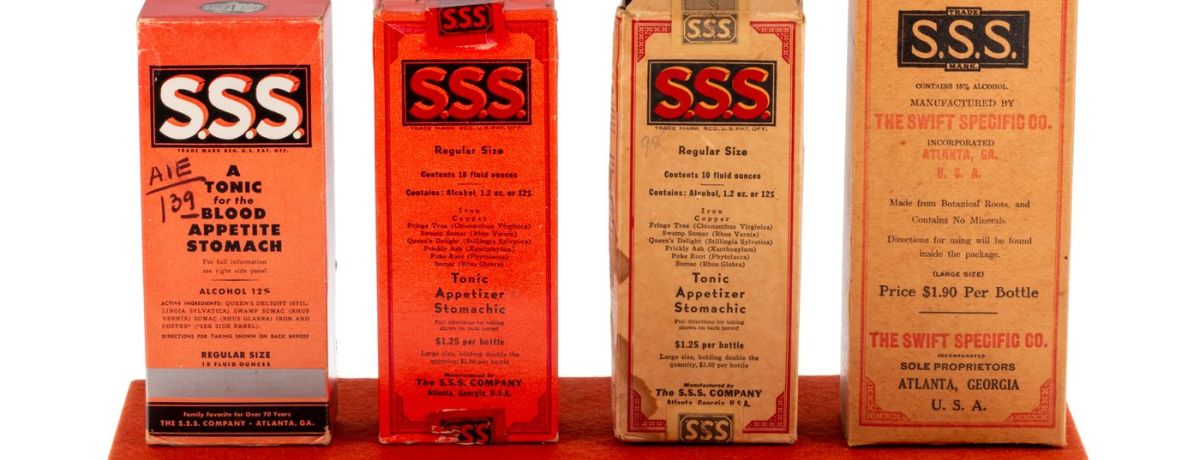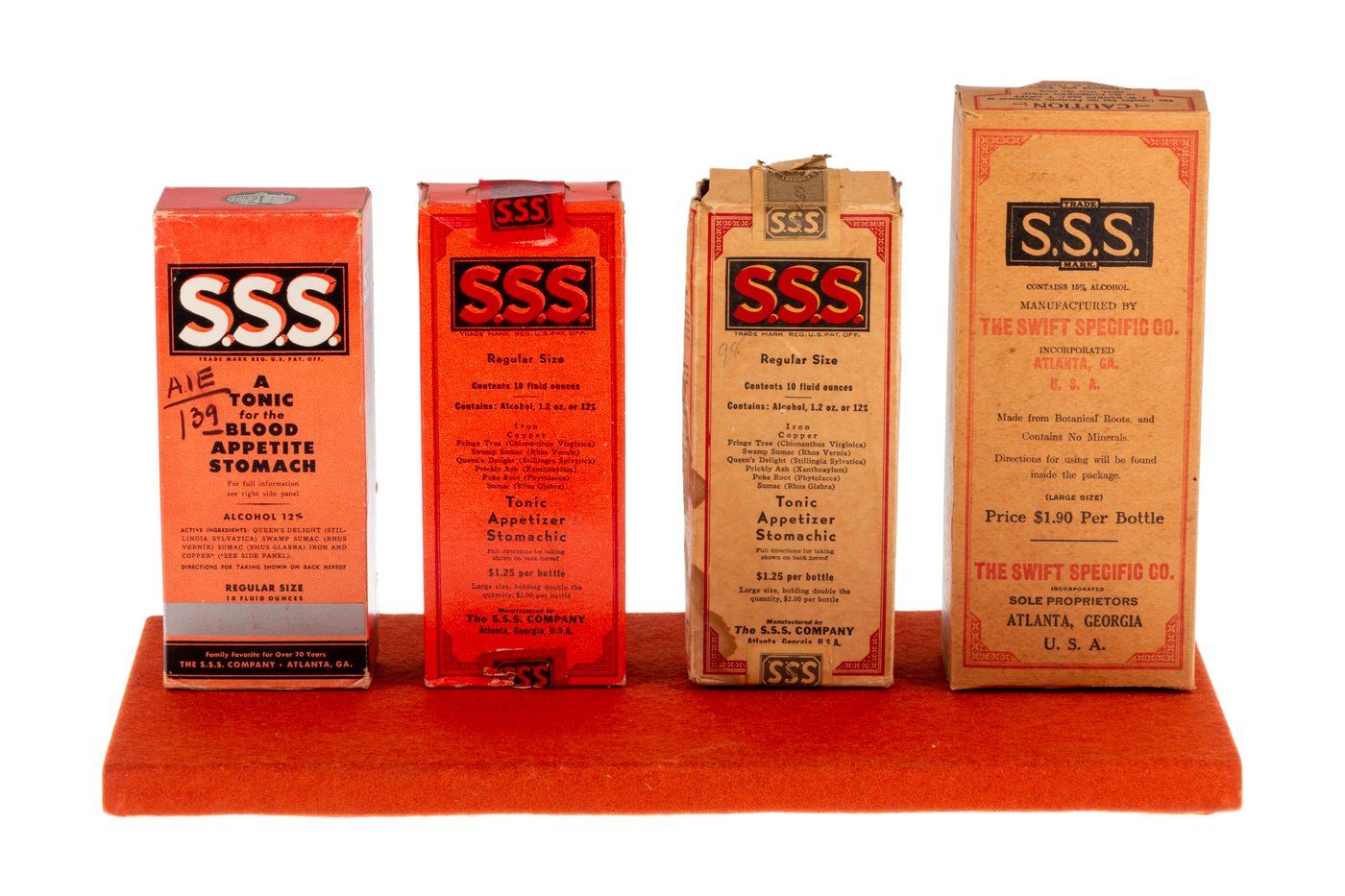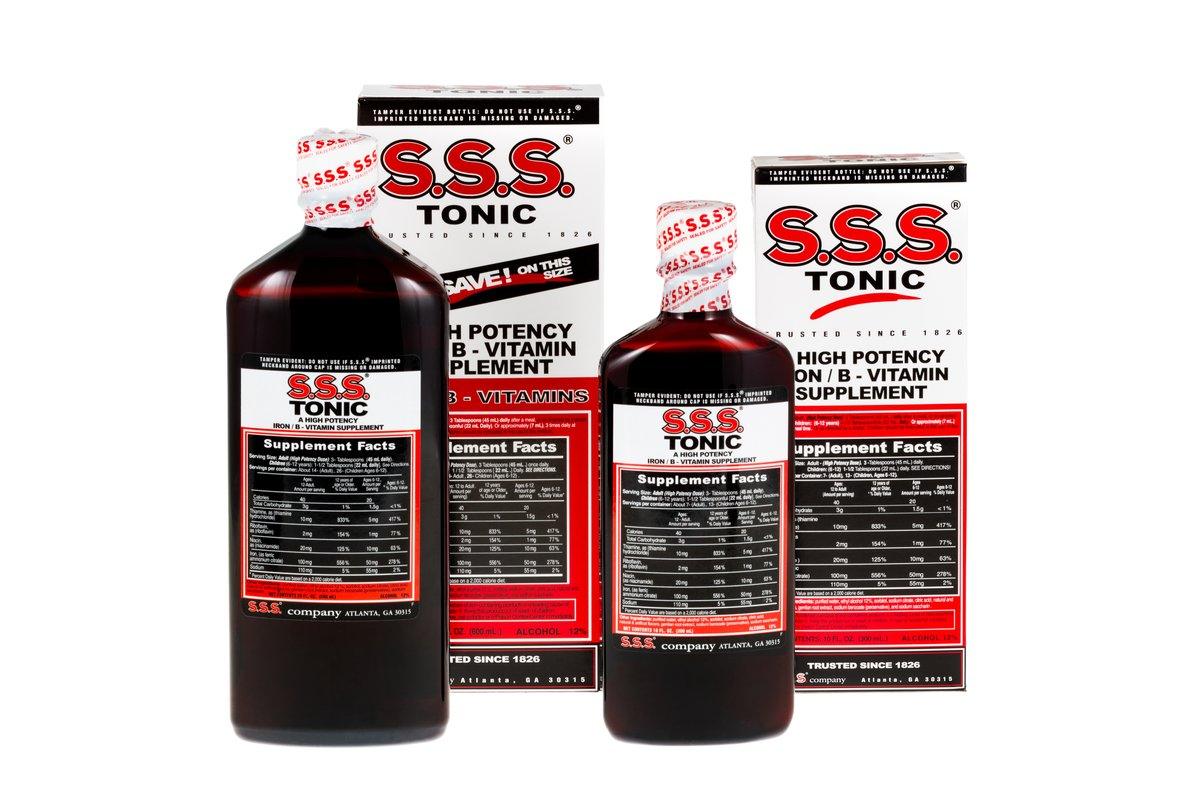The Packaging History of S.S.S. Tonic
The story of S.S.S. Tonic kicks off dramatically in 1826, originating as a valued Creek Indian remedy gifted to Captain Irwin Dennard in Perry, Georgia. From these unique roots, it was acquired and commercialized by Colonels Swift and Lamar, initially known as "Swift's Southern Specific," eventually leading to The S.S.S. Company in Atlanta by 1873.
Get Updates About SSS Products (Discounts, Guides & Historical Insights)
While its founding tale is fascinating, the journey of the product itself is equally compelling. More than just a container, the packaging of S.S.S. Tonic tells a story—a story of American ingenuity, changing tastes, evolving scientific understanding, and a brand that has stood the test of time.
This post delves into the evolution of S.S.S. Tonic packaging through the decades, exploring how the packaging of the tonic has changed, adapted, and reflected the eras through which it has passed. Join us as we unbox this history, revealing over a hundred years of evolution.
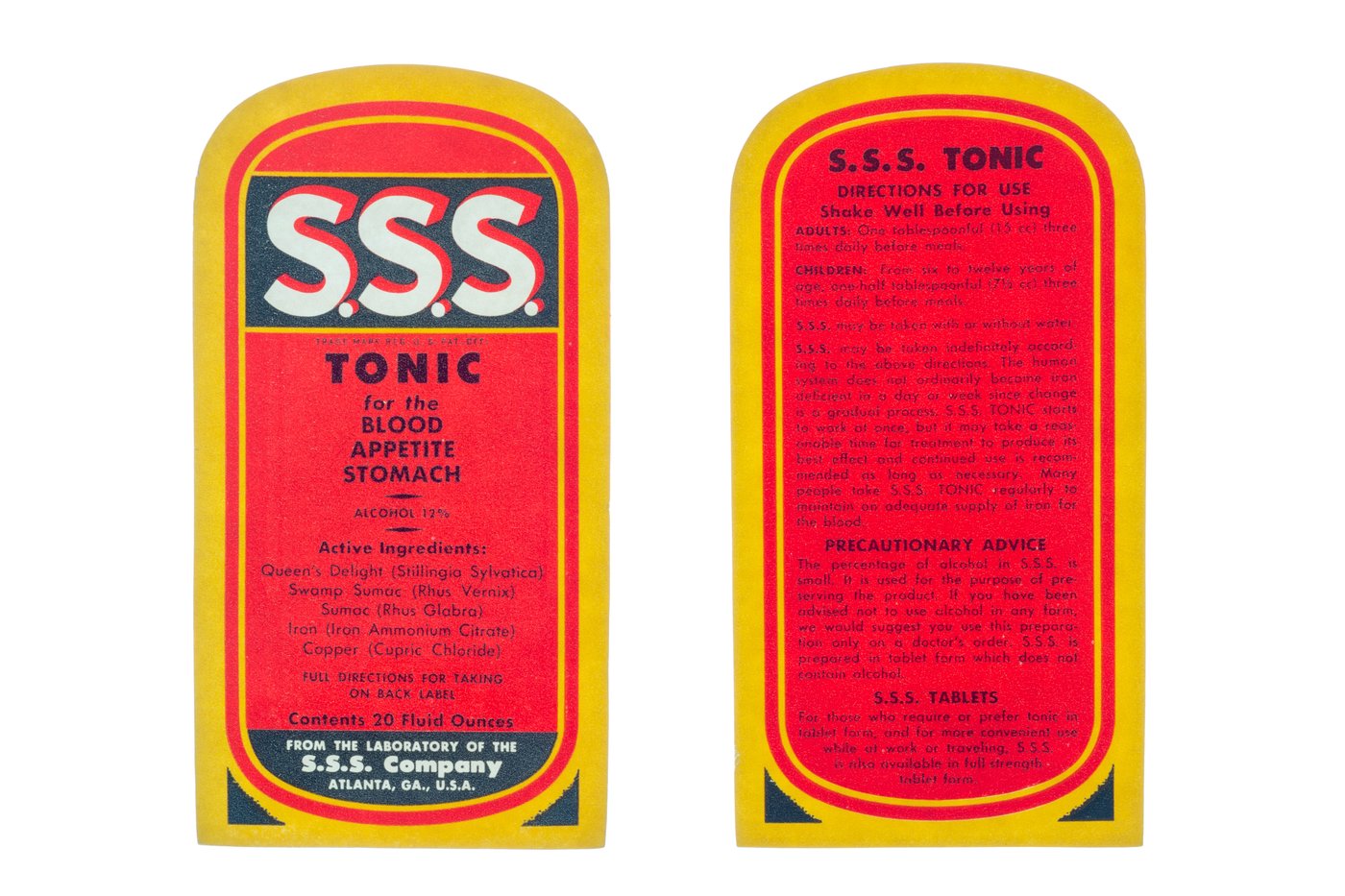
An Early S.S.S. Tonic Flyer: Claims, Cures, and Consumer Advice
An early window into our product's presentation is this S.S.S. Tonic flyer. The flyer employs a striking red and yellow color palette, a common choice in early 20th-century advertising designed to capture immediate attention. The typography is bold and authoritative, particularly the prominent "S.S.S. TONIC" lettering, instilling a sense of trust and efficacy. The straightforward claims—"for the BLOOD APPETITE STOMACH"—are typical of tonics from this period, which were often marketed for general well-being and to address a range of common ailments.
Flyer Front
S.S.S. TONIC
TRADE MARK REG. U.S. PAT. OFF.
for the BLOOD APPETITE STOMACH
ALCOHOL 12%
Active Ingredients:Queen's Delight (Stillingia Sylvatica)
Swamp Sumac (Rhus Vernix)
Sumac (Rhus Glabra)
Iron (Iron Ammonium Citrate)
Copper (Cupric Chloride)
FULL DIRECTIONS FOR TAKING ON BACK LABEL
Contents 20 Fluid OuncesFROM THE LABORATORY OF THE S.S.S. Company
ATLANTA, GA., U.S.A.
The listed active ingredients, such as Queen's Delight (Stillingia Sylvatica) and various Sumacs, connect directly to its Creek Indian remedy origins, emphasizing its natural roots. The inclusion of Iron and Copper positions the tonic for blood health, likely targeting common ailments like fatigue or what was often generally termed "low blood." The prominent "TRADE MARK REG. U.S. PAT. OFF." indicates the company's early efforts to protect its brand identity.
Flyer Back
S.S.S. TONIC
DIRECTIONS FOR USE
Shake Well Before Using
ADULTS: One tablespoonful (15 cc) three times daily before meals.
CHILDREN: From six to twelve years of age, one-half tablespoonful (7½ cc) three times daily before meals.
S.S.S. may be taken with or without water.
S.S.S. may be taken indefinitely according to the above directions. The human system does not ordinarily become iron deficient in a day or week since change is a gradual process. S.S.S. TONIC starts to work at once, but it may take a reasonable time for treatment to produce its best effects and continued use is recommended as long as necessary. Many people take S.S.S. TONIC regularly to maintain an adequate supply of iron for their blood.
PRECAUTIONARY ADVICE
The percentage of alcohol in S.S.S. is small. It is used for the purpose of pre-serving the product. If you have been advised not to use alcohol in any form, we would suggest you use this preparation only on a doctor's order. S.S.S. is prepared in tablet form which does not contain alcohol.
S.S.S. TABLETS
For those who require or prefer tonic in tablet form, and for more convenient use while at work or traveling, S.S.S. is also available in full strength tablet form.
Alcohol, Alternatives, and Managing Expectations
The 12% alcohol content was standard for many tonics of the era, serving as a preservative and, for some, perceived as part of their efficacy. The "Precautionary Advice" is insightful; it shows an early awareness of varying consumer needs or perhaps the beginnings of societal dialogue about alcohol in medicines. Crucially, it cleverly introduces S.S.S. Tablets as an alcohol-free alternative, broadening its appeal. The detailed dosage instructions, coupled with the advice that benefits may take time ("it may take a reasonable time for treatment to produce its best effects"), managed consumer expectations and encouraged sustained use—a savvy approach for the time.
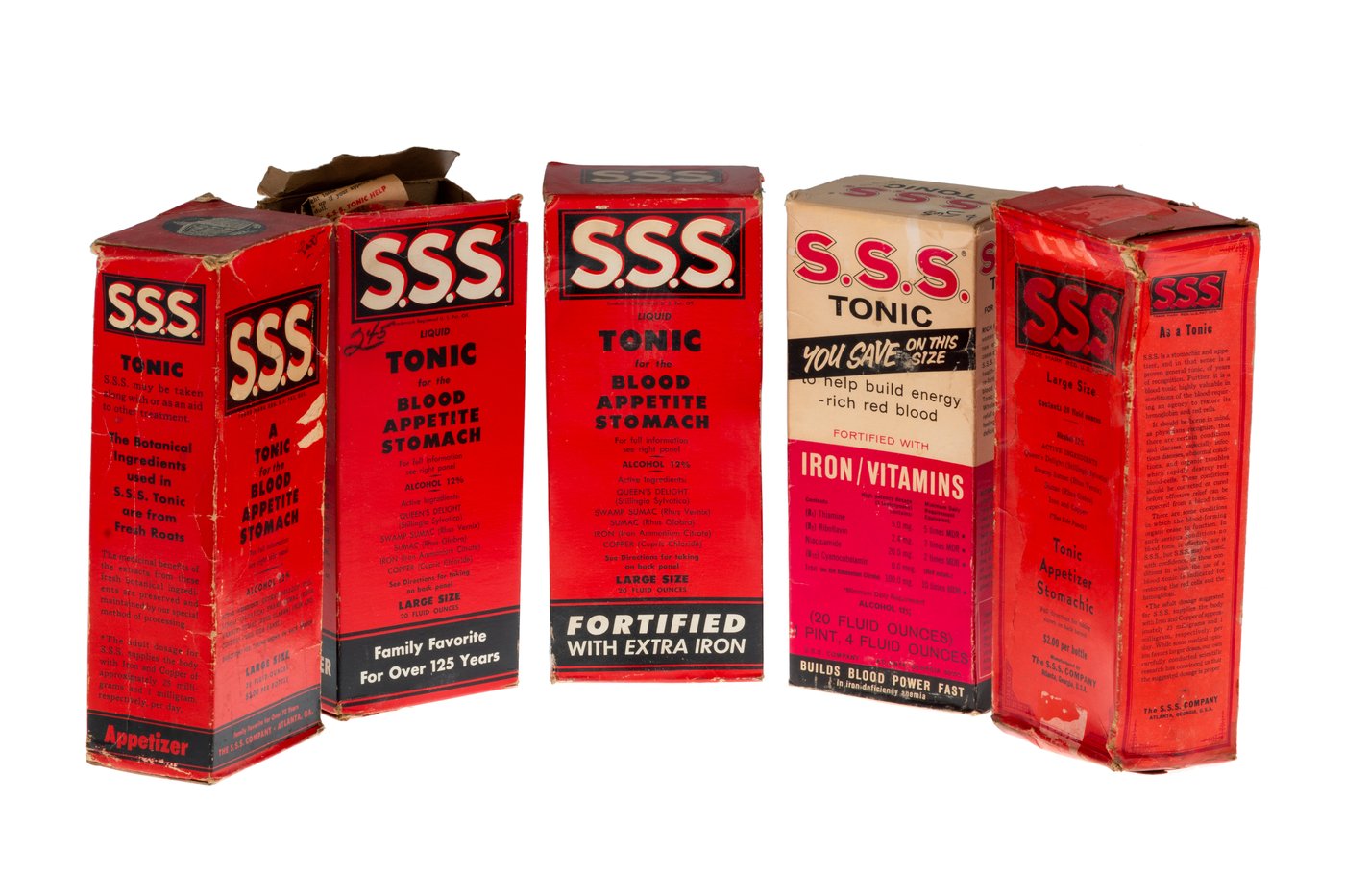
Unboxing History: The Evolution of S.S.S. Tonic Box Packaging
With as much history as we have, the S.S.S. tonic has been packaged in numerous ways. Many of these older products, including some of the oldest ones, can be found in our Atlanta offices, offering a tangible connection to our past.
The Oldest Tonic Box: A Window to a Bygone Era
The following brown, packaged, and sealed version of the tonic is the oldest version of the tonic box we have preserved. Let's explore the different sides of this aged product.
The first image shows the front of this old packaging, which still has the bottle inside. The branded paper strip of tape at the top is the seal that was used on these products during that era—a fascinating detail showcasing an early method of ensuring product integrity and authenticity before plastic seals became common. The box itself is made of sturdy cardboard, printed in a classic, no-nonsense style.
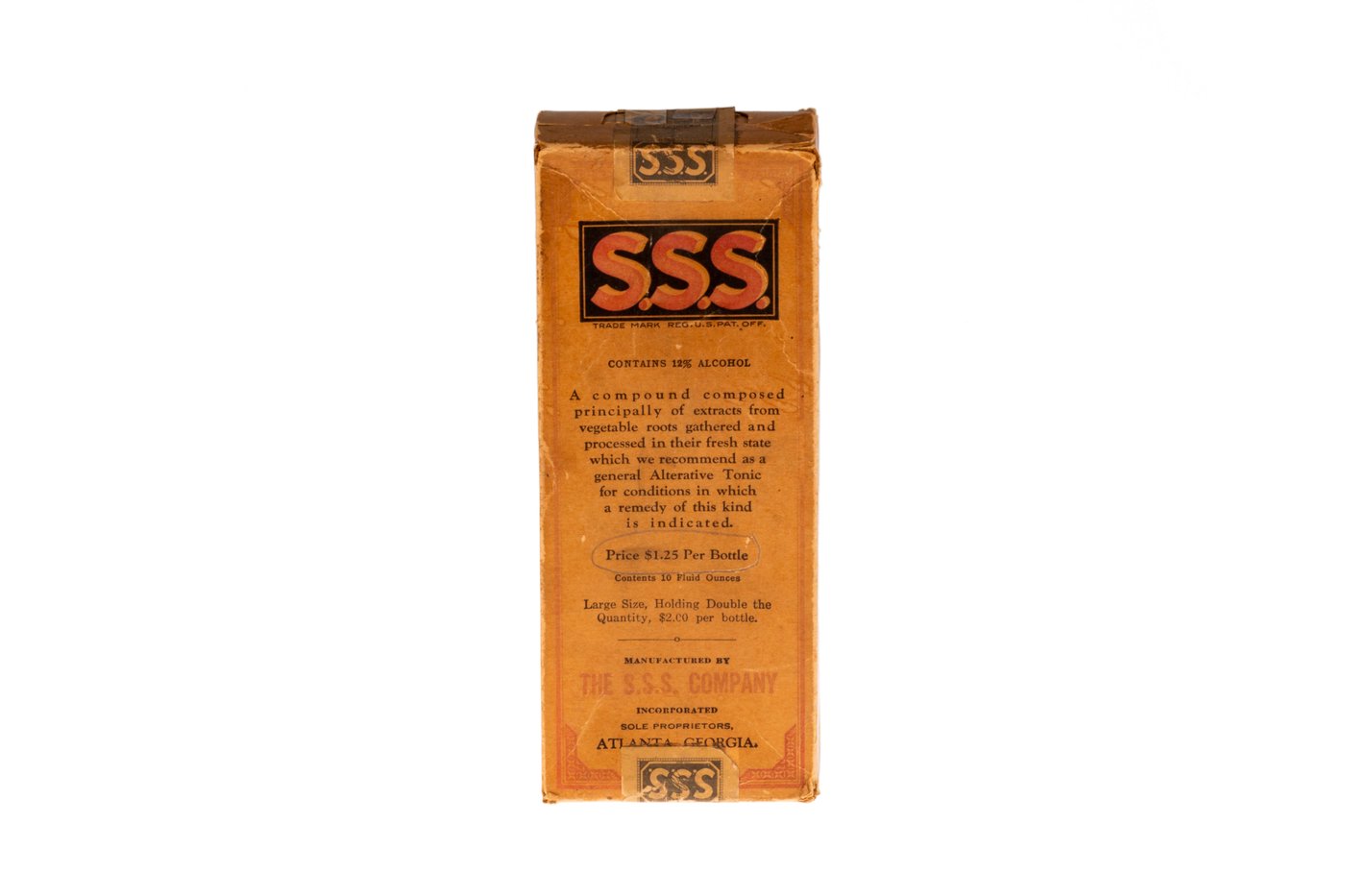
Here's the writing on the front of the packaging for easier reading.
SSS
TRADE MARK REG. U.S. PAT. OFF.
CONTAINS 12% ALCOHOL
A compound composed principally of extracts from vegetable roots gathered and processed in their fresh state which we recommend as a general Alterative Tonic for conditions in which a remedy of this kind is indicated.
Price $1.25 Per Bottle
Contains 10 Fluid Ounces
Large Size, Holding Double the Quantity, $2.00 per bottle.
MANUFACTURED BY
THE S.S.S. COMPANY
INCORPORATED
SOLE PROPRIETORS,
ATLANTA, GEORGIA.
Interpreting the Past
The language "A compound composed principally of extracts from vegetable roots gathered and processed in their fresh state" emphasizes the natural origins and the company's involvement in sourcing, appealing to a desire for natural remedies. The term "Alterative Tonic" is a historical medical term for substances believed to favorably alter the course of an illness or improve overall health. The mention of "$1.25 Per Bottle" and a "Large Size... $2.00 per bottle" gives us a snapshot of the product's cost and consumer options in that era.
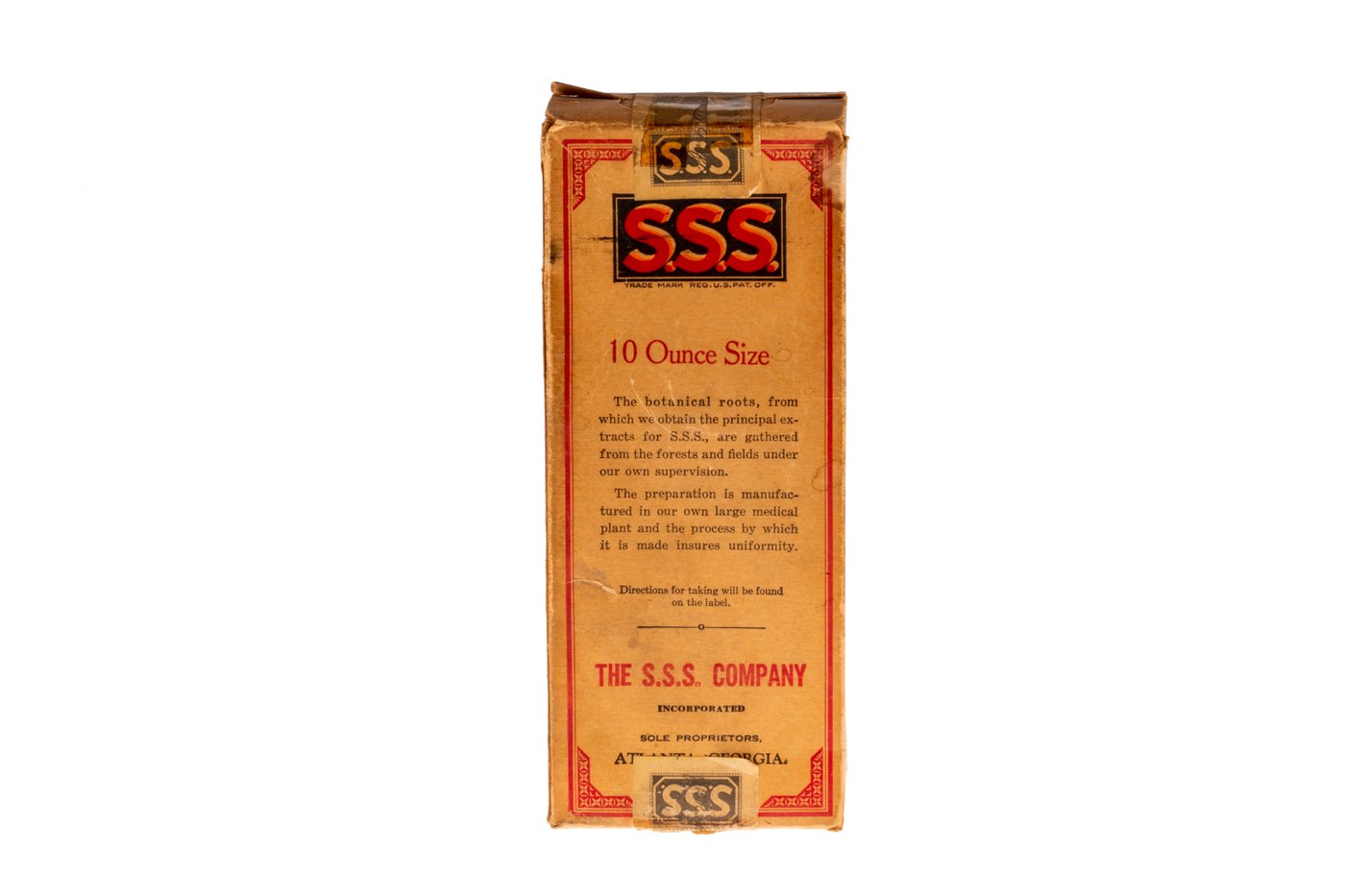
There are a few more details on the back of the box. Here's what the wording says.
SSS
TRADE MARK REG. U.S. PAT. OFF.
10 Ounce Size
The botanical roots, from which we obtain the principal extracts for S.S.S., are gathered from the forests and fields under our own supervision.
The preparation is manufactured in our own large medical plant and the process by which it is made insures uniformity.
Directions for taking will be found on the label.
THE S.S.S. COMPANY
INCORPORATED
SOLE PROPRIETORS.
ATLANTA, GEORGIA
A Global Reach from Early On
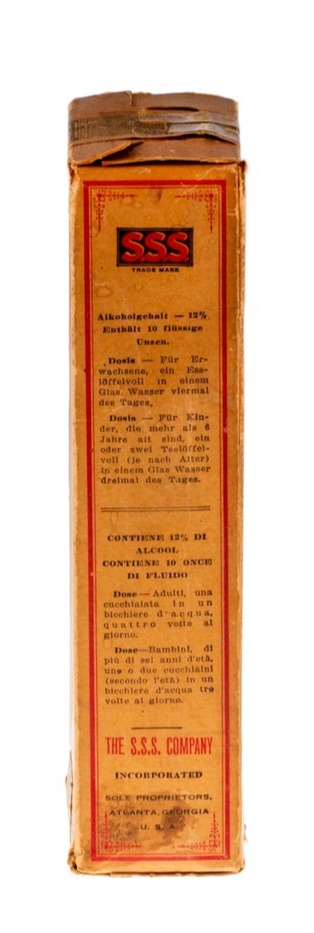

What you'll notice on the sides of this oldest box is that the language is not just English! Our tonic was sold in a variety of locations around the world, or at least marketed to diverse communities. On both sides, we have details in Polish, Spanish, German, and Italian. This indicates S.S.S. Company's early ambitions and success in reaching broader markets.
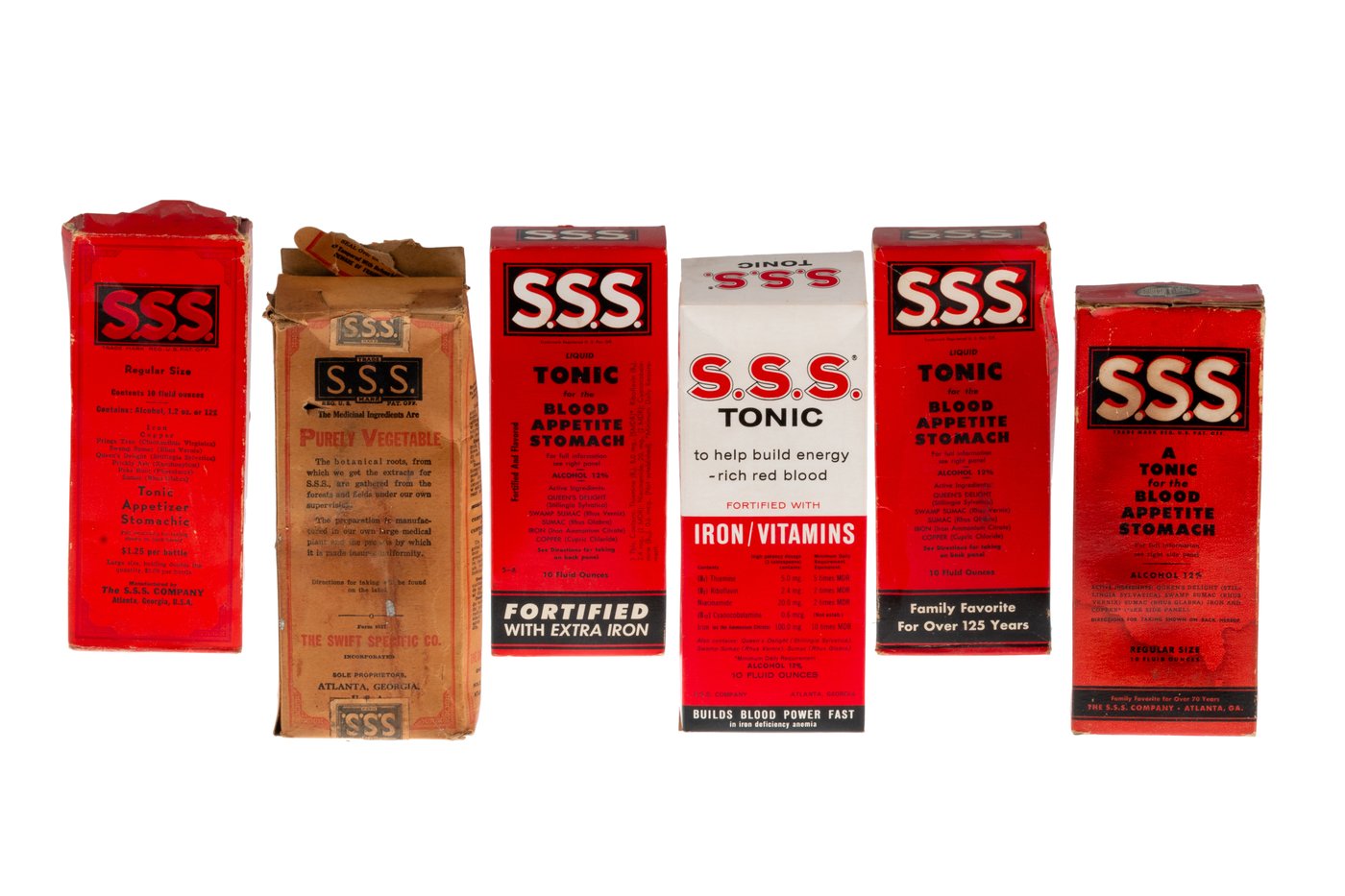
A Cavalcade of Cartons: Box Designs Through the Decades
As the decades progressed, the S.S.S. Tonic box underwent several transformations, reflecting new printing technologies and evolving design aesthetics.
- Color Evolution: Later boxes often adopted a bold red. This vibrant hue became a signature color for the brand, effectively conveying energy and strength.
- Messaging Shifts: The claims and product descriptions also evolved. Some later boxes prominently feature phrases like "FORTIFIED WITH IRON/VITAMINS" or "BUILDS BLOOD POWER FAST." This marks a shift towards more specific, benefit-oriented language, possibly reflecting advances in nutritional science and more direct marketing approaches. The phrase "Tonic Appetizer Stomachic" also appears, refining the targeted benefits.
- Layout and Typography: The typography and the "SSS" logo itself also underwent modernizations over time, reflecting the graphic design trends of different eras. While maintaining its core identity, the presentation adapted.
- Enduring Trust: On some packaging variations, claims like "Family Favorite for Over 125 Years" appear, a powerful testament to brand longevity and the trust built with consumers over generations.
Bottling History: The S.S.S. Tonic Bottle Collection
The bottles themselves tell their own story, from their shape and color to the labels they bear.
Glimpses of the Earliest S.S.S. Bottles
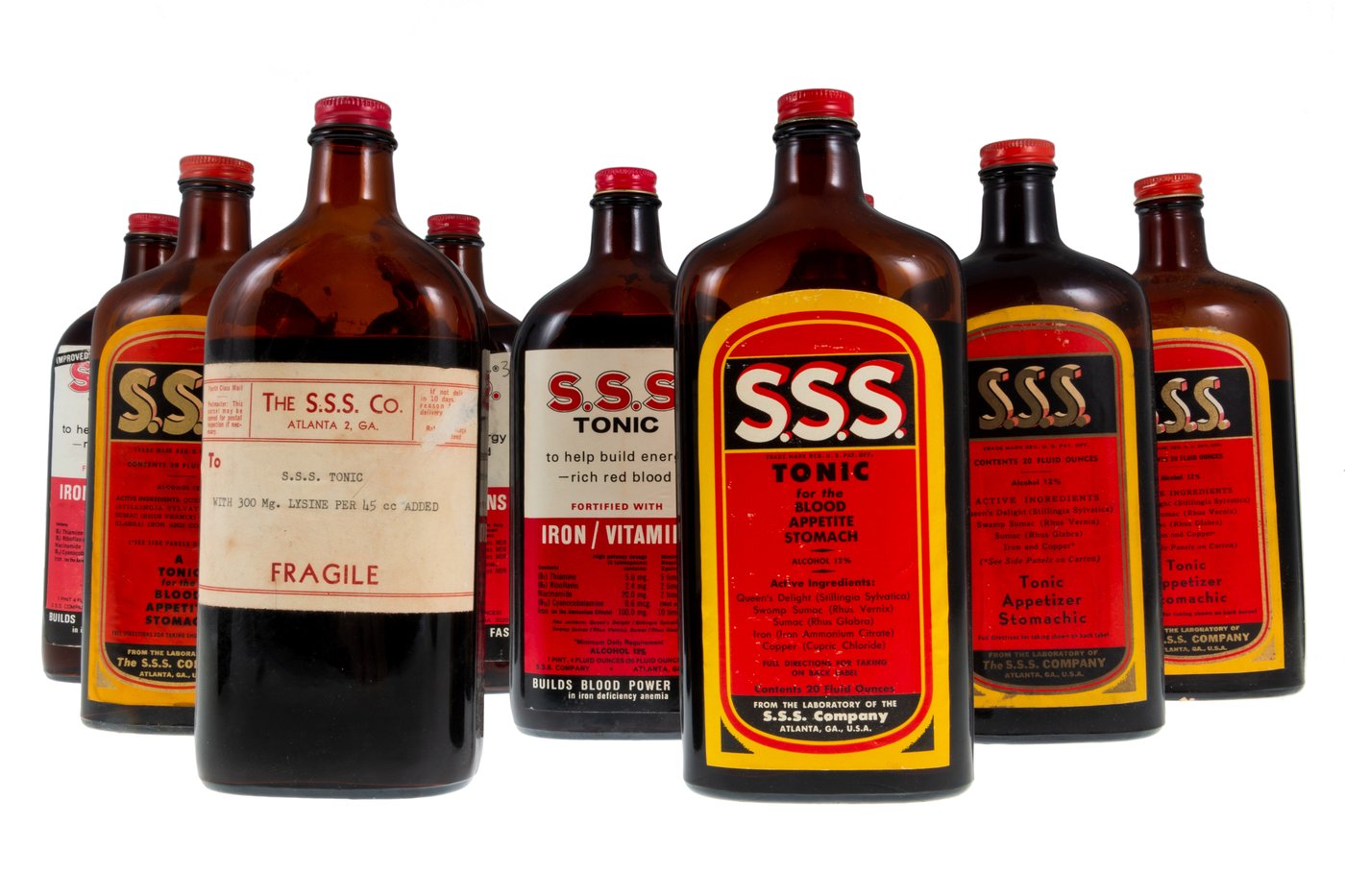
The bottles above and below are a collection of S.S.S. Tonic we've stored over the decades. The bottle (with a paper seal still intact over the cap) and the standalone bottle (both below) are two of the oldest examples we have in our archives.
Physical Characteristics
These early S.S.S. Tonic bottles are typically made of amber or brown glass. This was a common choice for medicinal products as it helped protect the contents from light degradation. The shapes of these bottles, with their distinct shoulders and necks, were characteristic of their time.
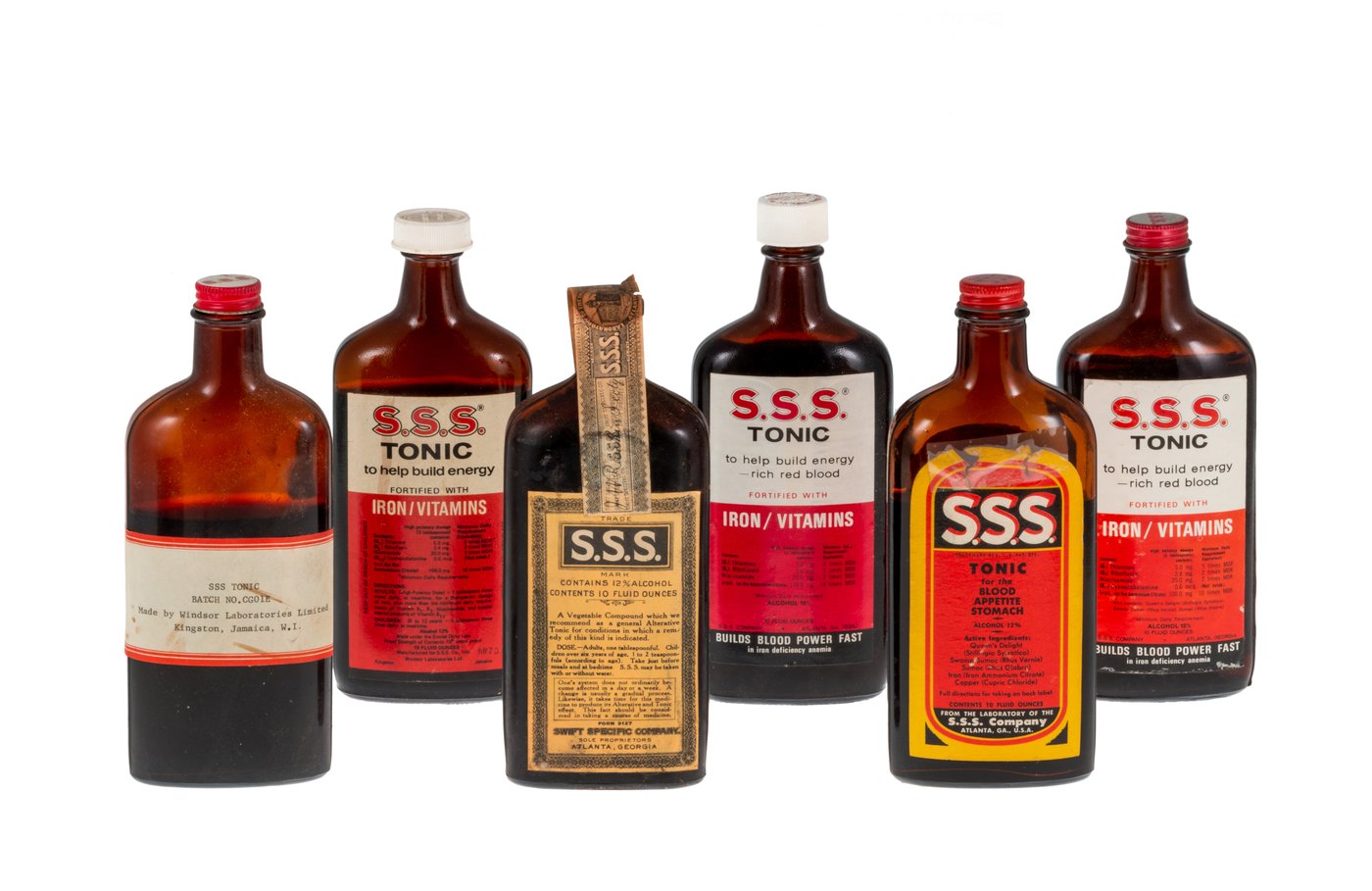
Above (the middle bottle with a seal) and below are two of the oldest bottles of SSS Tonic we've got stored in our archives.
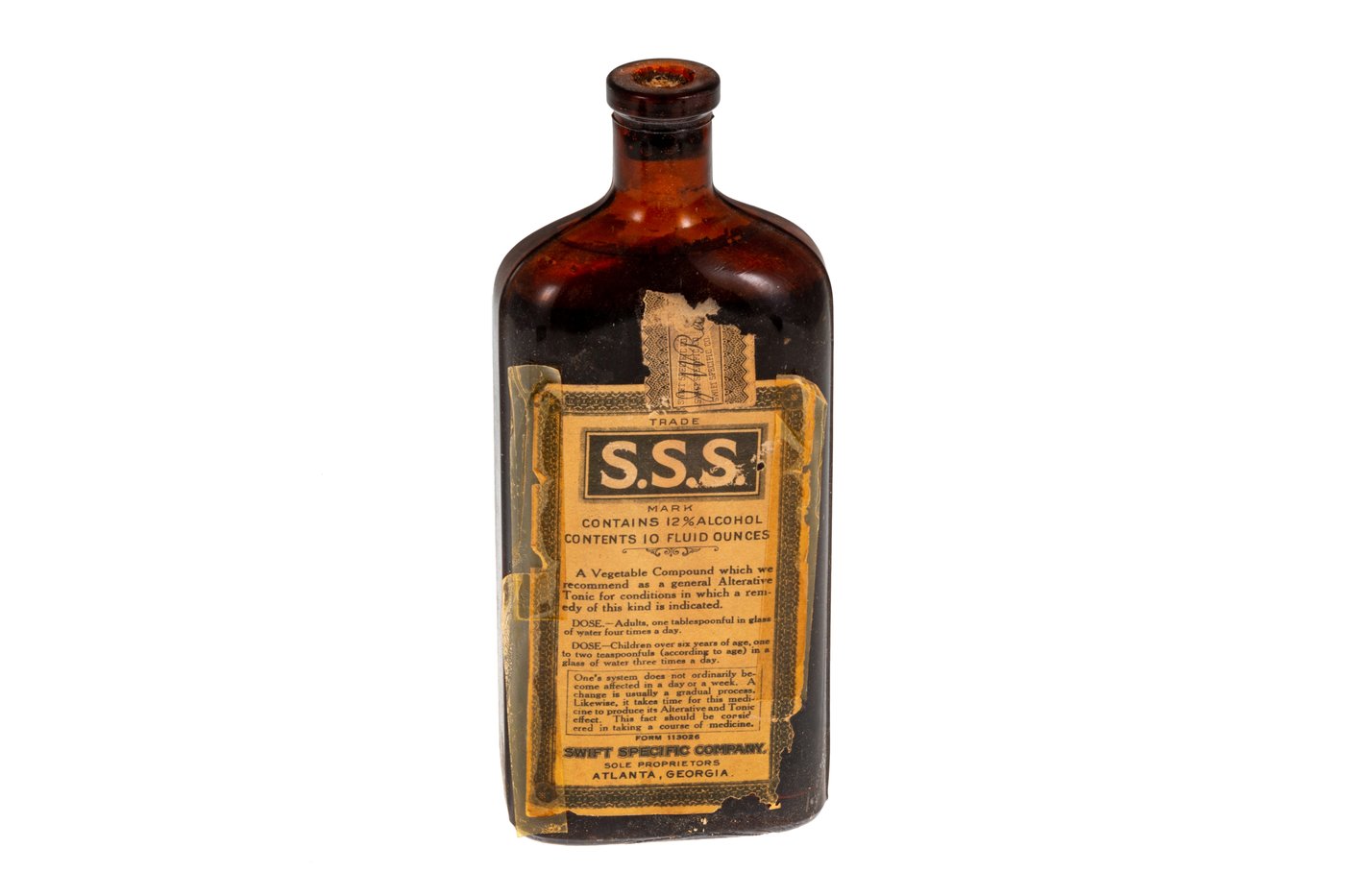
Here's the bottle label text.
Trade
S.S.S.
MARK
CONTAINS 12% ALCOHOL
CONTENTS 10 FLUID OUNCES
A Vegetable Compound which we recommend as a general Alterative Tonic for conditions in which a remedy of this kind is indicated.
DOSE—Adults, one tablespoonful in glass of water four times a day.
DOSE—Children over six years of age, one to two teaspoonfuls (according to age) in a glass of water three times a day.
One's system does not ordinarily become affected in a day or a week. A change is usually a gradual process. Likewise, it takes time for this medicine to produce its Alterative and Tonic effect. This fact should be considered in taking a course of medicine.Form 113026
SWIFT SPECIFIC COMPANY
SOLE PROPRIETORS
ATLANTA, GEORGIA
Decoding the Label
The paper label, likely applied with adhesive, has a formal design. The "Trade S.S.S. MARK" is prominently displayed. Interestingly, this older label names the "SWIFT SPECIFIC COMPANY," providing a tangible link to the product's earlier name, "Swift's Southern Specific," before it was more commonly known solely as The S.S.S. Company. The "Form 113026" at the bottom is an internal tracking number for the label design or printing batch. Some bottles may even feature embossing directly on the glass (e.g., "S.S.S. Company" or "Atlanta, GA"), a durable branding technique of the past.
A Visual Timeline in Glass
Our broader collection showcases a fascinating array of S.S.S. Tonic bottles, visually narrating the brand's journey. We see variations in bottle height, shape, and closure types (evolving from corks in the very earliest versions, to the screw caps visible in many of these photos).
Label Evolution
Color palettes on labels shifted from more monochrome or two-tone older labels to the introduction of more color, mirroring changes in box packaging. The core "S.S.S." branding remains central, but surrounding text, fonts, and decorative elements adapt. Some later labels clearly state "IRON/VITAMINS" or "to help build energy - rich red blood," reflecting the marketing focus seen on corresponding boxes.
Behind the Scenes: Production Samples
Beyond consumer packaging, our archives also contain production samples, offering a behind-the-scenes look at our quality control and product development processes. As part of the production and flavor testing process, S.S.S. Co. has had samples made of the tonic. Here are photos of some of those bottles.
Sample from LaWall & Harrisson (1965)
One label, dated 9/10/1965, comes from "LaWall & Harrisson, Research & Control Laboratories, Inc." in Philadelphia. S.S.S. Company utilized external laboratories for testing—a standard practice for ensuring quality and consistency.

FROM: LaWALL & HARRISSONResearch & Control Laboratories, Inc.BACTERIOLOGICAL CHEMICAL PHARMACOLOGICAL1921 WALNUT STREETPHILADELPHIA, PA., 19103S. S. S. TONICNo root extractivesRegular FlavorColored with acid proof caramel9/10/1965
Insights from the Sample
The detail "No root extractives" is particularly intriguing. It suggests that in 1965, the company was testing formulations that potentially deviated from the original "extracts from vegetable roots." This could have been for reasons of cost, consistency, modernizing the formula, or exploring different active ingredients. The "Regular Flavor" notation implies other flavor variants might have been under consideration, and "Colored with acid proof caramel" specifies the coloring agent for stability and appearance.
S.S.S. Co. Lysine Sample
Another fascinating sample shows a version of S.S.S. Tonic with an added ingredient. The "Atlanta 2, Ga." address format might offer a clue to its specific era, as postal zone use evolved.
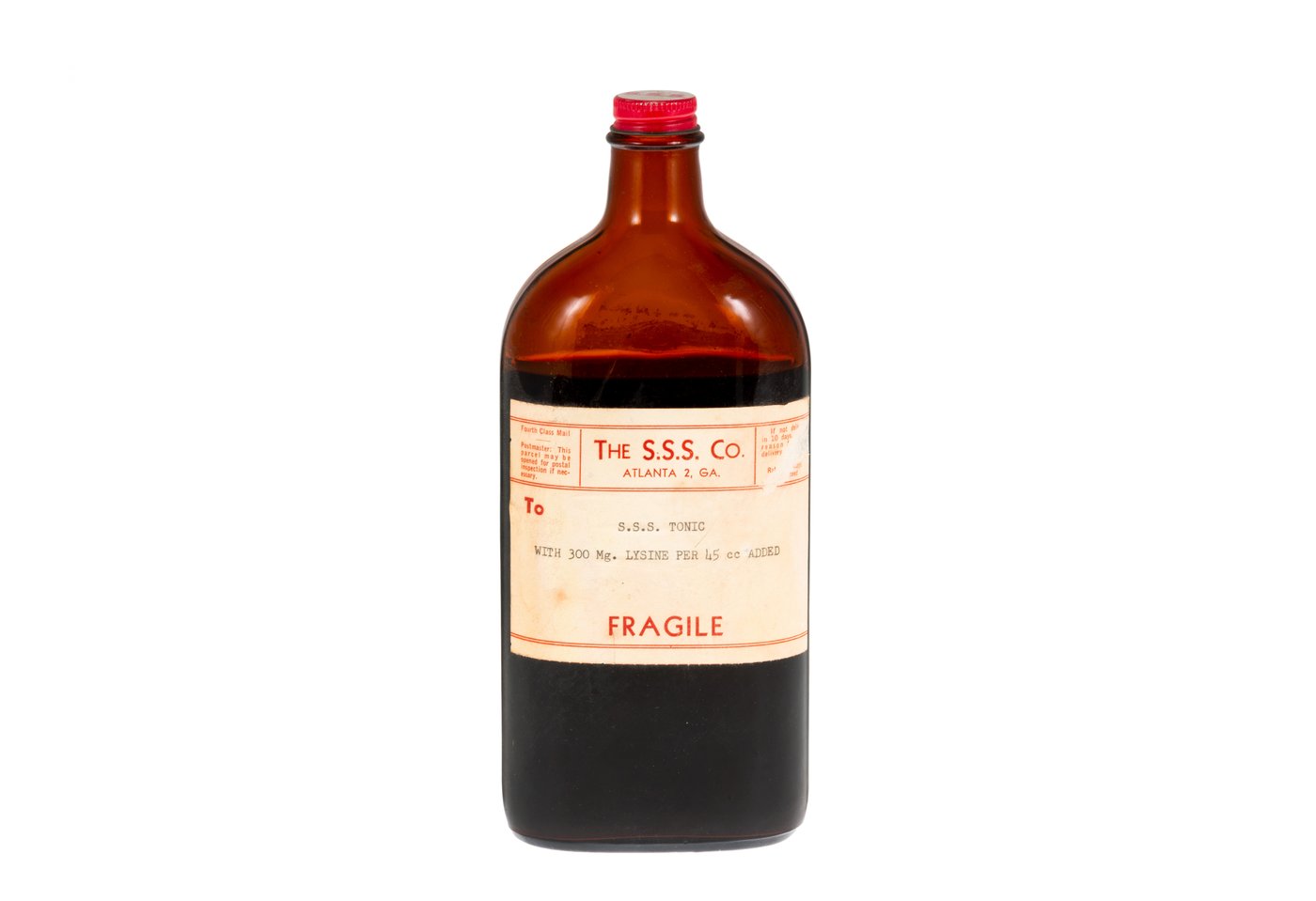
Here's the bottle label text.
The S.S.S. Co.Atlanta 2, Ga.To:S.S.S. TonicWith 300 Mg. Lysine per 45 cc addedFRAGILE
Exploring Enhancements
This sample, with "300 Mg. Lysine per 45 cc added," shows S.S.S. Co. was actively exploring ways to enhance its product based on contemporary nutritional science. Lysine is an essential amino acid, and in the mid-20th century, research into fortifying foods and supplements with amino acids for various health reasons was common. The practical "FRAGILE" marking highlights the care needed in transporting these test samples.
Packaging in Context: Reflecting Broader Historical Trends
The evolution of S.S.S. Tonic packaging didn't happen in a vacuum. It was influenced by, and reflects, broader historical currents:
- Regulatory Landscapes: The language and claims on medicinal packaging have been significantly shaped by evolving regulations, such as the Pure Food and Drug Act of 1906 and the Federal Food, Drug, and Cosmetic Act of 1938 in the U.S. These acts brought increasing requirements for ingredient listings, verifiable claims, and safety.
- Technological Advancements: Changes in printing technology, glass and cardboard manufacturing, and sealing methods all played a role in how S.S.S. Tonic was presented.
- Design Aesthetics: The graphic design styles seen on S.S.S. Tonic packaging over the years—from more traditional layouts to cleaner, more modern presentations—are a mirror to the broader aesthetic trends of each era.
- Economic Factors: Events like wartime (e.g., WWI, WWII) could have impacted material availability (like metals for caps or certain types of paper), potentially influencing packaging choices, though specific impacts on S.S.S. would require deeper archival research.
A Legacy in Layers: Conclusion
The journey of S.S.S. Tonic's packaging is a rich narrative layered with history, science, and artistry. From the earliest hand-applied labels and glass-stoppered bottles (presumed) to the more familiar boxes and bottles of later decades, each iteration tells a part of our story. We see a brand that carefully guarded its core identity—the prominent "S.S.S."—while adapting its presentation to meet the changing times, scientific understanding, and consumer expectations.
Behind every bottle and box is a human story—the workers who meticulously crafted and filled them, the marketers who envisioned their appeal, the pharmacists and storekeepers who stocked them on their shelves, and ultimately, the generations of consumers who welcomed S.S.S. Tonic into their homes, all leading to our current version of the tonic seen below!
We'd Love to Hear From You!
Do you have an old S.S.S. Tonic bottle or box in your family's collection?
Perhaps a memory of seeing it in your grandparents' medicine cabinet?
Which era of S.S.S. Tonic packaging resonates most with you?
